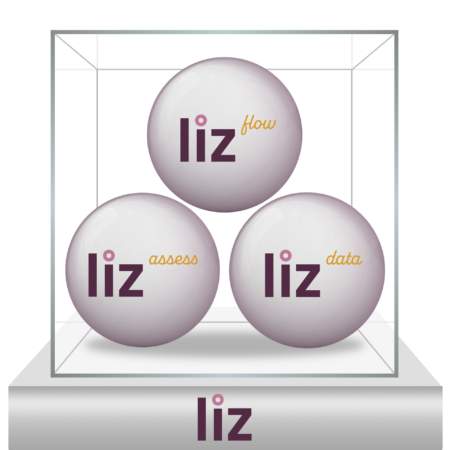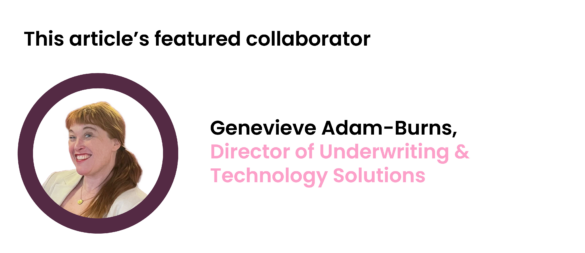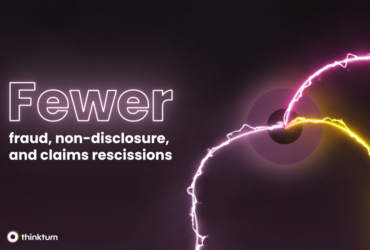The Value of Transparency in a Customer Journey

Hyper-personalization has completely changed how customer journeys are conducted and policies sold; but having full visibility into the system makes that journey so much more compelling for both the organization and the applicant. thinktum explains how in this article.
Are you old enough to remember salesmen going door to door to sell life insurance policies? This happened for decades (and it still occurs in some parts of North America) and was pretty successful. Of course, in 2020 when a pandemic hit, the few remaining people who were once open to a home visit by a stranger selling insurance finally declined these meetings as well.
Some larger firms had an online application, while others just used editable PDFs to collect information. This was not exactly the height of technology, although frankly, it was a step up from the fax machine. But just barely.
The obvious solution to that problem is in providing an online customer journey to those who would prefer to buy insurance online. They absolutely do not want an agent calling them to go over a list of 30 health questions. How do you sell someone something if they aren’t interested in your kind of relationship? You change the way you do business.
The organizations that have added an online application flow seem to better understand how people want to buy insurance now. They are looking for a fast application process. No one wants to be answering 100 health-related questions just to be turned down in the end. People want questions relevant to their age and health status, and they sure don’t want questions asked that relate to the other gender. This is especially true with a younger market who are looking for a fast and frictionless experience. To dig deeper into the benefits of tailor-made journeys, read Hyper-personalization paves the road to success.
This is all due to the power of artificial intelligence (AI). AI has the ability to slice and dice through enormous piles of data. It can fuel a chatbot, adapt questions based on answers provided, and in thinktum’s case, extrapolate information to provide a logical assessment.
Organizations are invested in keeping costs down, and aren’t interested in having to hire expensive technical staff, redeploy existing staff, or train up in-house staff on some technology they feel may not still be credible down the road.
If AI is so great, why doesn’t everyone use it?
The AI Black-Box Phenomena
Traditionally, artificial intelligence solutions were built with zero visibility into the system. If an organization was using an AI component, they were not privy to the way decisions that occurred inside that black box were made, or to how AI relates to other components in order to make them. Questions were asked and answered, AI took care of leading to the next step, and that was the end of it. Insurers simply had to trust the process happening within while using it. It’s a bit like a magic trick – we can’t peek into the magician’s top hat to see that the rabbit was always there. We’re just surprised when the rabbit appears.
CTOs are less enamored with buying something they don’t have control over or can at the very least understand. That opacity doesn’t help anyone.
thinktum’s liz modular suite allows the business vision into every aspect of the application flows as they happen. The liz flow module acts as the Pure no-code canvas in which flows can be created, edited, and tested. liz assess is our hyper-personalized underwriting rules engine module. It has two functions: first, liz assess acts as a triage flow as the data gets entered. Next, it provides a decision recommendation based on the data provided. Every new question is based on the previous answer, delivering the most hyper-personalized application flow in the industry. This ensures a far more rigid decision than ever before. If a particular question requires editing, an underwriter can complete the change on the fly in a matter of a few seconds. Finally, our liz data module is AI-driven. It crunches the data and provides robust analytics and insightful alerts on crucial elements through an elegant and intuitive dashboard. Everything that’s needed, all in one single crystal-clear place. Deploy all three modules together for the very best holistic solution.
thinktum’s Glass-Box Solutions
thinktum has been working on these concerns which are somewhat being addressed in the market already, but our Pure no-code solution suite is fully transparent. You can update flows, change questions, or affect outcomes; the customization is endless. The best part about our liz software is that it’s see-through. Every step of the journey can be followed along with before a decision is made. Our modular suite has all the functionality you’ve been dreaming about: your own branding and user interface, unambiguous decisions, tailored flows, and a robust and secure dashboard that correlates all of your data in a single easy-to-use interface.
Our data analytics module provides stakeholders the ability to understand more about their processes and applicants. You’ll know how many times Mary changed an answer, or where users drop off, and you’ll be able to trace back each step of their journey to ascertain why applicants are prematurely quitting the application process. liz data can also tell you about completion hurdles and misbehaviors. All in a Pure no-code environment that lets your IT resources take care of other business. Buy only the modules you need. That’s the marvel of modular.

Coding Required vs. Pure No-Code
The hesitation we see most often comes in the form of concern regarding technical assets. Medium to large insurers are not interested in any solution that requires a large time or technology investment. They simply don’t have the expertise, technical resources, or intestinal fortitude to rebuild all of their infrastructures. Luckily for them, thinktum’s liz suite just sits on top of any existing e-application, supercharging it within minutes of uploading the system.
We asked our Director of Underwriting & Technology Solutions, Genevieve Adam-Burns to weigh in.
If you wanted or needed to change something (even something as dumb as a spelling mistake), you had to go back to the Project Managers, then you needed to have a meeting on it, then they would need to take it back to the Full Stack Development team who would then go into the coding and fix it. That could take 2, possibly 3 weeks. By the time it comes back to you, you think, I don’t even want this question included anymore!”
System implementation can happen within a few days instead of months. Any staff can be trained up easily – no IT resources are needed, and applicants will much prefer a shorter application process that only asks them relevant questions.
Here’s Adam-Burns again:
We believe really strongly in this type of modeling. It makes it easier for customers and gives them a far better journey, which is going to lead to a better claims experience. But people want to know how our solution is going to save their organization money. How is it going to save them regarding resources, or how it will save them time. So, that’s important because you know, I certainly tend to be more philosophical in that I think insurance is noble and it can be noble again.”
Glass box and no-code means faster, seamless implementation, visibility into the system, fully customizable journeys, and better ROI. Business stakeholders finally have the visibility and control they’ve been lacking for years.
Request a demo today!






